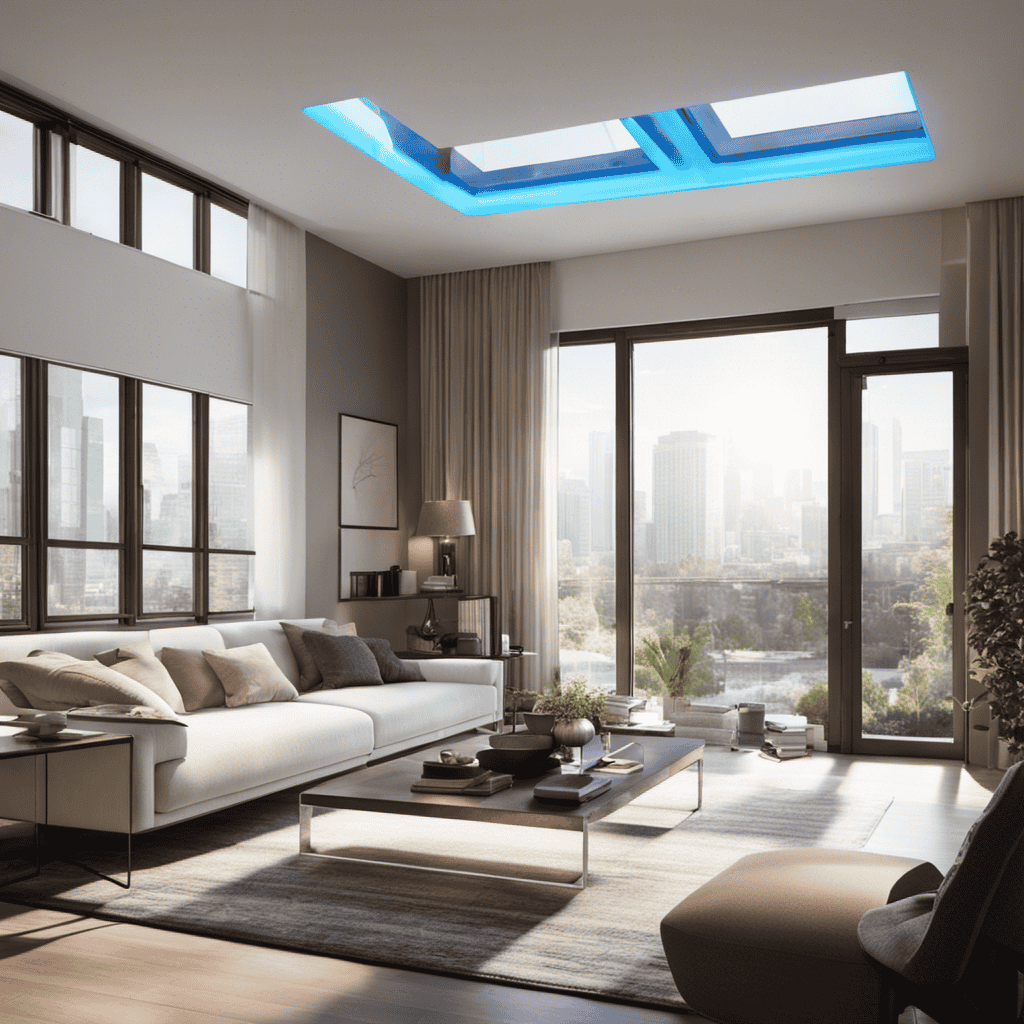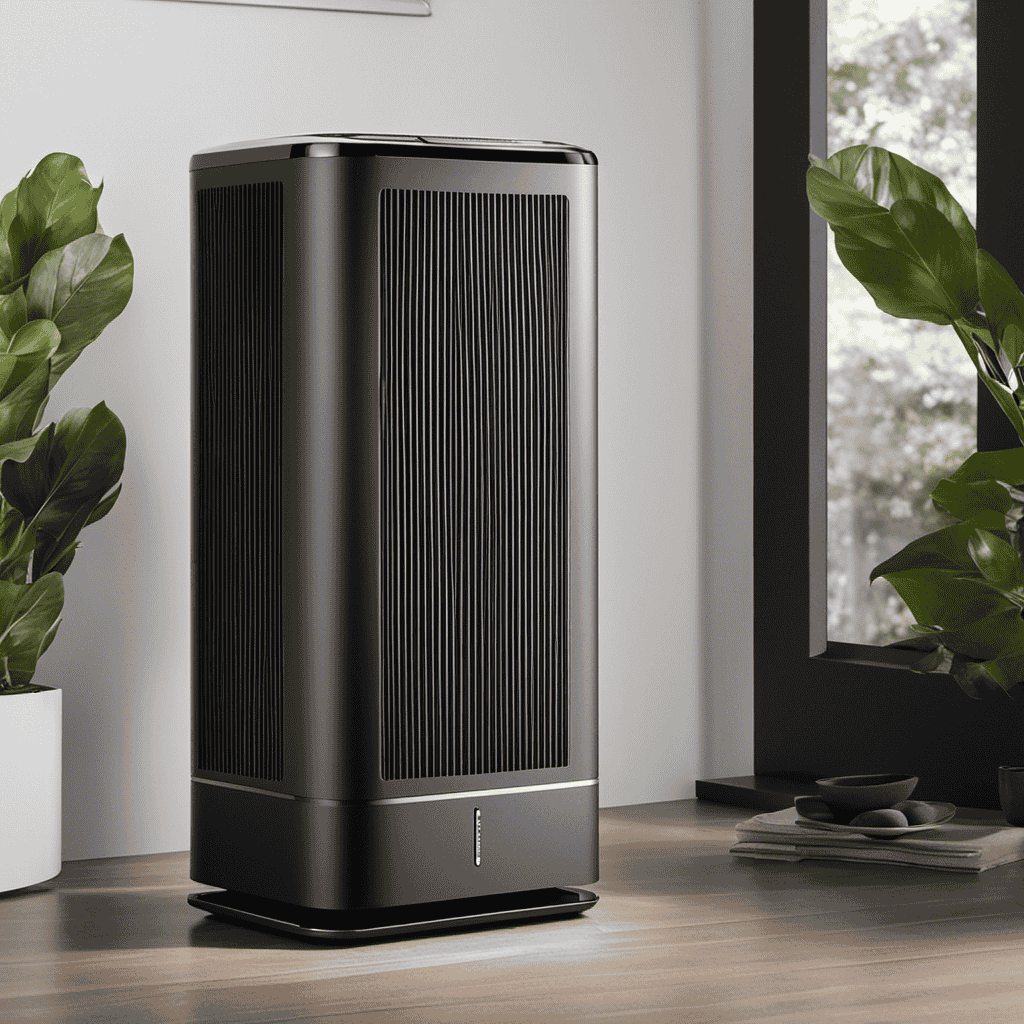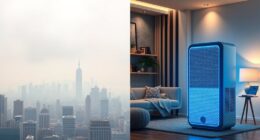Every time I take a breath of that fresh, **clean air**, it hits me how awesome my HEPA air purifier is. It’s not just any gadget; it’s a total lifesaver for making the air inside my place way better.
With its advanced filtration technology, it efficiently removes dust, allergens, and pollutants, creating a healthier living environment.
In this article, I will delve into the benefits, workings, and key features of a HEPA air purifier, debunking common misconceptions along the way.
Let’s dive in and uncover the secrets behind this remarkable piece of technology.
Key Takeaways
- HEPA air purifiers significantly reduce allergens and pollutants in the air.
- HEPA filters capture particles as small as 0.3 microns with 99.97% efficiency.
- HEPA air purifiers improve indoor air quality and make it safer to breathe.
- Proper sizing and capacity of the air purifier contribute to its overall efficiency and effectiveness.
Benefits of Using a HEPA Air Purifier
Using a HEPA air purifier can significantly reduce allergens and pollutants in the air. These devices are known for their energy efficiency and cost effectiveness.
HEPA, which stands for High-Efficiency Particulate Air, refers to a type of filter that can capture particles as small as 0.3 microns with an efficiency of 99.97%. This means that even the tiniest particles, such as pollen, pet dander, and dust mites, are effectively trapped and removed from the air.
By reducing these airborne particles, HEPA air purifiers can greatly improve indoor air quality, making it safer and healthier to breathe. Furthermore, their energy-efficient design ensures that they consume minimal power, resulting in lower electricity bills.
Transitioning into the next section, let’s explore how exactly a HEPA air purifier works.
How Does a HEPA Air Purifier Work
To understand how it works, you’ll want to know that a HEPA air purifier filters out tiny particles and allergens from the air. This highly efficient technology is designed to improve indoor air quality and alleviate allergies and asthma symptoms. HEPA stands for High-Efficiency Particulate Air, and these purifiers use a dense filter to trap 99.97% of particles as small as 0.3 microns.
Let’s take a closer look at the energy efficiency of HEPA air purifiers. These devices typically have low power consumption, making them energy efficient and cost-effective to run continuously. They also come with different fan speeds, allowing you to adjust the airflow based on your needs and conserve energy when necessary.
In terms of impact, HEPA air purifiers have been proven to significantly reduce allergens and irritants in the air. This can lead to a noticeable improvement in allergy and asthma symptoms, providing relief for those suffering from these conditions.
| Benefits of HEPA Air Purifiers | ||
|---|---|---|
| High-Efficiency Filtration | Energy Efficient | Improved Indoor Air Quality |
| Allergen and Irritant Reduction | Allergy and Asthma Relief | Cost-effective Solution |
Key Features to Look for in a HEPA Air Purifier
When it comes to choosing a HEPA air purifier, there are several key features that should be taken into consideration.
First, noise level considerations are important, as some air purifiers can be quite loud and disruptive in a quiet environment.
Second, filter replacement frequency is crucial to maintain the effectiveness of the purifier, and it is important to choose a model that has easily accessible and affordable replacement filters.
Lastly, coverage area size is a key factor to consider, as different air purifiers have different capacities and are designed for different room sizes.
Noise Level Considerations
The noise level of an HEPA air purifier should be taken into account before purchasing one. When choosing an air purifier, it is important to consider the noise level to ensure it won’t disrupt your daily activities or sleep. Here are three key factors to consider when evaluating the noise level of an HEPA air purifier:
-
Soundproofing options: Look for air purifiers that offer soundproofing features such as noise-reducing insulation or a quiet mode. These options can help minimize the noise produced by the purifier, allowing for a peaceful environment.
-
User-friendly controls: Opt for air purifiers with intuitive controls that allow you to adjust the fan speed or noise level easily. This will enable you to tailor the noise output to your preference and create a more comfortable living space.
-
Noise decibel rating: Pay attention to the manufacturer’s specifications regarding the noise level, usually measured in decibels (dB). A lower decibel rating indicates a quieter operation, making it an essential consideration for noise-sensitive areas like bedrooms or offices.
Considering these factors will help you select an HEPA air purifier that strikes a balance between effective air filtration and minimal noise disturbance.
Filter Replacement Frequency
Consider the manufacturer’s recommendations for filter replacement frequency to ensure optimal performance of your device.
The frequency at which you should replace your air purifier’s filters is crucial for maintaining clean and healthy air in your space. Ignoring this recommendation can lead to decreased efficiency and increased energy consumption.
When filters become clogged with pollutants, the air purifier has to work harder to circulate air, resulting in higher energy consumption and potentially higher utility costs. Additionally, neglecting to replace filters regularly can lead to decreased filter effectiveness, allowing more airborne particles to circulate in your space.
While there may be an upfront cost associated with filter replacement, it is a small investment compared to the potential health risks and increased energy consumption that can result from not replacing filters as recommended.
Coverage Area Size
In my previous discussion, I emphasized the importance of maintaining clean filters in an HEPA air purifier. Now, let’s delve into the coverage area size of these devices.
The room size and air circulation play a vital role in determining the effectiveness of an air purifier. Here are three key points to consider:
-
Room Size: HEPA air purifiers come in various sizes, designed to cater to different room sizes. It is crucial to choose a purifier that matches the dimensions of your room to ensure optimal air purification.
-
Air Circulation: The efficiency of an air purifier depends on how well it can circulate and filter the air in a room. Consider factors such as the placement of the purifier and the number of air changes per hour for effective air cleaning.
-
Additional Considerations: Factors like ceiling height, furniture placement, and the presence of obstacles can impact air circulation. Ensure proper positioning and unobstructed airflow for the best results.
Understanding HEPA Filtration Technology
Understanding HEPA filtration technology is crucial when choosing an air purifier. HEPA, which stands for High Efficiency Particulate Air, is a type of filter that is designed to remove 99.97% of particles that are 0.3 microns or larger in size.
This technology is highly effective in capturing dust, pollen, pet dander, and other airborne pollutants, making it an ideal choice for those with allergies or respiratory conditions.
Maintaining an air purifier with HEPA filtration is relatively simple. Regularly replacing the filter is essential to ensure optimal performance and clean air quality.
The benefits of clean air cannot be overstated. Breathing in clean air can improve overall health and well-being, reduce respiratory symptoms, and create a more comfortable living environment.
Investing in an air purifier with HEPA filtration is a smart choice for anyone who values their health and wants to breathe in clean, fresh air.
Common Misconceptions About HEPA Air Purifiers
Don’t be misled by some common misconceptions about HEPA filtration technology in air purifiers. Contrary to popular belief, HEPA air purifiers are not a waste of money or ineffective. In fact, they are highly effective in improving indoor air quality by removing harmful pollutants and allergens.
Here are three common myths about air purifiers that need to be debunked:
-
Myth: Air purifiers are only for people with allergies or respiratory issues. Fact: Air purifiers benefit everyone by reducing the presence of dust, pet dander, and other airborne particles, leading to a cleaner and healthier environment.
-
Myth: Air purifiers eliminate all types of odors. Fact: While air purifiers can help reduce certain odors, they are not designed to eliminate strong or persistent odors like cigarette smoke or cooking smells.
-
Myth: Air purifiers require frequent maintenance. Fact: HEPA filters in air purifiers typically last for several months and only require occasional replacement, making them convenient and cost-effective.
Understanding these facts about air purifiers can help you make an informed decision and choose the right air purifier for your needs.
Choosing the Right Size and Capacity for Your HEPA Air Purifier
Now that we have cleared up some misconceptions about HEPA air purifiers, let’s move on to another important aspect of owning one: air purifier maintenance and troubleshooting common issues.
Maintaining your HEPA air purifier is crucial to ensure its optimal performance and longevity. Regular maintenance includes cleaning or replacing the filters, cleaning the unit’s exterior, and checking for any signs of damage or wear.
Troubleshooting common issues such as unusual noises, weak airflow, or a malfunctioning display can help you quickly identify and resolve any problems that may arise.
By following proper maintenance procedures and troubleshooting techniques, you can keep your HEPA air purifier running smoothly and effectively.
Now, let’s dive into some maintenance tips for your HEPA air purifier.
Maintenance Tips for Your HEPA Air Purifier
Let’s explore some tips for maintaining your HEPA air purifier to ensure its optimal performance. Proper maintenance techniques are essential to keep your air purifier functioning effectively and efficiently. Here are three important steps to follow:
-
Regularly clean or replace the filters: HEPA filters trap particles and pollutants, but over time, they can get clogged and lose their effectiveness. Cleaning or replacing the filters every three to six months is crucial for maintaining clean and healthy air.
-
Clean the exterior and vents: Dust and dirt can accumulate on the surface of your air purifier, hindering its performance. Wipe down the exterior regularly with a soft cloth and clean the vents to prevent blockages.
-
Troubleshooting tips: If your air purifier is not working properly, check the power source, ensure the filters are properly installed, and consider resetting the unit. If the issue persists, consult the manufacturer’s manual or contact customer support for further assistance.
Can an Air Purifier with Ion Feature Replace a Hepa Air Purifier?
Can an air purifier with ion feature replace a HEPA air purifier? Many people wonder about the effectiveness of ion purifiers compared to HEPA filters. While HEPA filters capture particles in a physical filter, what ion does air purifier refers to the process of releasing charged ions into the air to attract pollutants. While ion purifiers can be beneficial, they may not be as efficient as HEPA filters in removing smaller particles. It is recommended to choose an air purifier that combines both technologies for optimal purification.
Frequently Asked Questions
Can a HEPA Air Purifier Remove All Types of Pollutants From the Air?
Yes, a HEPA air purifier can remove all types of pollutants from the air. Its high-efficiency filters capture particles as small as 0.3 microns, making it effective in reducing indoor pollutants and benefiting respiratory health.
Can a HEPA Air Purifier Eliminate Odors and Smoke?
Yes, a HEPA air purifier can eliminate odors and smoke. I was amazed by how effectively it removed pet dander, pollen, and dust particles. HEPA filters are highly efficient in reducing indoor air pollution.
Is It Necessary to Replace the HEPA Filter in a HEPA Air Purifier?
Yes, it is necessary to replace the HEPA filter in a HEPA air purifier. It is cost effective because it ensures the purifier continues to improve indoor air quality by removing allergens, dust, and other particles.
Can a HEPA Air Purifier Help With Allergies and Asthma?
Using a hepa air purifier has been a game-changer for my allergies and asthma. The effectiveness and benefits of using one are remarkable. It’s like having a personal bodyguard against allergens and irritants.
Can a HEPA Air Purifier Be Used in Large Rooms or Open Spaces?
Yes, a HEPA air purifier can be used in large rooms or open spaces. It is effective at filtering out allergens and pollutants, making it a good choice for those with allergies or asthma. Compared to other types of air purifiers, HEPA filters are known for their high efficiency.
Conclusion
After diving deep into the world of HEPA air purifiers, I’ve come to the ironic conclusion that these devices are nothing short of magical.
With their advanced filtration technology, they have the power to remove even the tiniest particles from the air we breathe.
It’s fascinating how something so sleek and compact can have such a profound impact on our indoor air quality.
So, if you want to transform your home into a sanctuary of purity and freshness, investing in a HEPA air purifier is the way to go.










